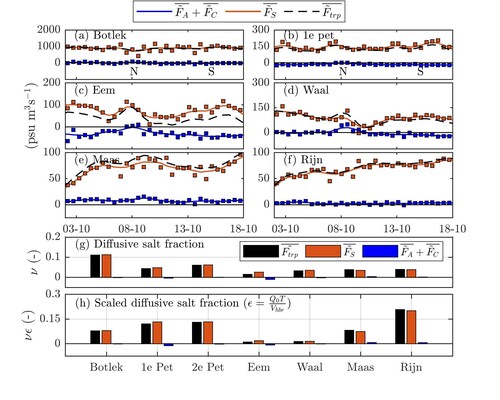D. van Keulen1,3, W.M. Kranenburg2,3 , A.J.F. Hoitink1
1 Wageningen University, The Netherlands; 2 Delft University of Technology, The Netherlands; 3 Deltares, The Netherlands
* Daan.vankeulen@wur.nl
Introduction
Salt intrusion is known to be influenced by harbours and side channels. These features may enhance salt dispersion by temporarily trapping incoming salt water and releasing it later in the tidal cycle (Okubo, 1973; Dronkers,1978; MacVean and Stacey, 2011). While the contribution of these features to tidal dispersion is well-established for well-mixed estuaries, the governing processes in deeper (partially stratified) systems have remained less studied. In this study, we investigate the channel-harbour exchange in the New Meuse, a partially stratified branch of the Rhine-Meuse estuary.
Objective and Methods
We aim to determine the mechanisms of channel-harbour exchange in a partially stratified situation, explain where these mechanisms depend on and quantify the degree in which they contribute to salinity dispersion. For this, we study harbour basins in the New Meuse located just upstream of the junction with the Old Meuse and the New Waterway, a region characterized by large salinity gradients over short distances. During a field campaign, four shipboard surveys were conducted at two harbour basins under both spring and neap tide conditions, and the contribution of different exchange mechanisms was quantified using a decomposition of the instantaneous salt flux through the harbour entrance. Next, a numerical model of the Rhine-Meuse estuary was used to verify the field observations and assess the net salt flux resulting from channel-harbour exchange on an intertidal timescale (tidal trapping).
Results
The decomposition of the instantaneous fluxes through the harbour entrance revealed significant differences in the relative contributions of a vertically sheared exchange flow. A weak exchange flow was observed in the harbour, where the salinity range in the main channel was limited. Analysis of the exchange flow and salinity range suggests that the exchange flow is proportional to the salinity range raised to the power 3/2, which explains the observed differences. The harbour-induced additional up-estuary salt flux (tidal trapping) was found to be primarily driven by the dispersive effect of this exchange flow (Fig. 1). Given the sensitivity of exchange flow to the salinity range, harbours located in regions with a smaller salinity range contributed significantly less to the net up-estuary salt flux. This also explained why the largest harbours contributed the least to the up-estuary salt flux, which is contrary to expectations, as the storage/release flux typically scales with harbour size. The contribution of tidal filling and emptying of the harbour basins was found to be small and to dampen the additional up-estuary salt flux. Overall, the results indicate that in deeper systems, tidal trapping is governed by diffusive exchange, and the contribution of classical tidal trapping is negligible.

Overview of additional salt flux resulting from channel-harbour exchange. (a-f) Excursion-averaged additional salt flux ( (F ̃_trp ) ̅), contribution of the diffusive channel-harbour exchange (F ̃_S ) ̅ (mainly vertical exchange) and contribution of cross-sectional averaged exchange ( (F ̃_A ) ̅+(F ̃_C ) ̅), shown for different harbours in the New Meuse. (g) Excursion-averaged and time-averaged additional salt flux, shown as a fraction of the total up-estuary transport to balance flushing by river discharge (diffusive salt fraction) for different harbours. (h) Same as (g), but with scaled diffusive salt fraction to eliminate size differences.
References
Okubo, A. "Effect of shoreline irregularities on streamwise dispersion in estuaries and other embayments." Netherlands Journal of Sea Research 6.1-2 (1973): 213-224.
Dronkers, J.: Longitudinal dispersion in shallow well-mixed estuaries. In: Coastal Engineering 1978, pp. 2761–2777 (1978)
MacVean, L.J., Stacey, M.T.: Estuarine dispersion from tidal trapping: a new analytical framework. Estuaries and Coasts 34(1), 45–59 (2011)










